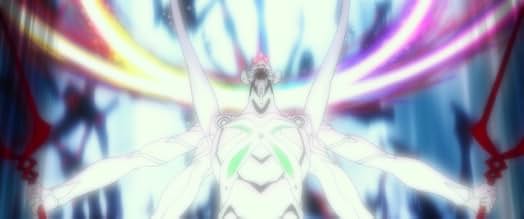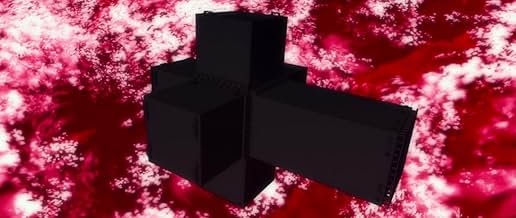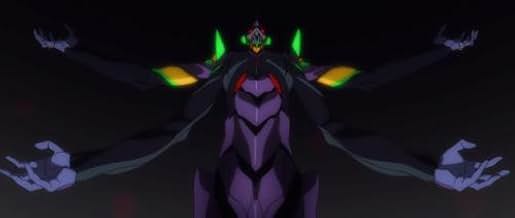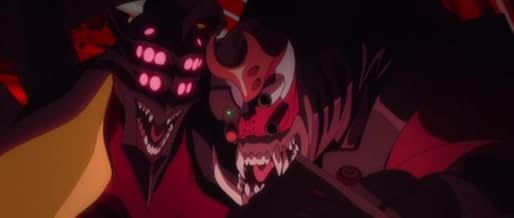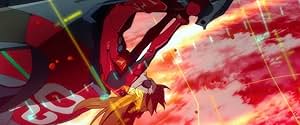Evangelion: 3.0: You Can (Not) Redo
Originaltitel: Evangelion Shin Gekijôban: Kyu
IMDb-BEWERTUNG
6,9/10
19.633
IHRE BEWERTUNG
Füge eine Handlung in deiner Sprache hinzuFourteen years have passed since the near Third Impact. Most of the world has changed, except for Shinji Ikari, who awakens in a strange new environment without having aged.Fourteen years have passed since the near Third Impact. Most of the world has changed, except for Shinji Ikari, who awakens in a strange new environment without having aged.Fourteen years have passed since the near Third Impact. Most of the world has changed, except for Shinji Ikari, who awakens in a strange new environment without having aged.
- Auszeichnungen
- 2 Nominierungen insgesamt
Megumi Ogata
- Shinji Ikari
- (Synchronisation)
Megumi Hayashibara
- Rei Ayanami (kashou)
- (Synchronisation)
- …
Yûko Miyamura
- Asuka Langley Shikinami
- (Synchronisation)
Maaya Sakamoto
- Mari Illustrious Makinami
- (Synchronisation)
Kotono Mitsuishi
- Misato Katsuragi
- (Synchronisation)
Akira Ishida
- Kaworu Nagisa
- (Synchronisation)
Yuriko Yamaguchi
- Ritsuko Akagi
- (Synchronisation)
Fumihiko Tachiki
- Gendo Ikari
- (Synchronisation)
Motomu Kiyokawa
- Kozo Fuyutsuki
- (Synchronisation)
Takehito Koyasu
- Shigeru Aoba
- (Synchronisation)
Hiro Yûki
- Makoto Hyuga
- (Synchronisation)
Miki Nagasawa
- Maya Ibuki
- (Synchronisation)
Miyuki Sawashiro
- Sakura Suzuhara
- (Synchronisation)
Akio Ôtsuka
- Kouji Takao
- (Synchronisation)
Sayaka Ôhara
- Sumire Nagara
- (Synchronisation)
Anri Katsu
- Hideki Tama
- (Synchronisation)
Mariya Ise
- Midori Kitakami
- (Synchronisation)
Mugihito
- Keel Lorenz
- (Synchronisation)
Handlung
WUSSTEST DU SCHON:
- WissenswertesThe post-credits preview for the next film, featuring EVA Unit 8+2 fighting, was created by motion capturing stuntmen rather than traditional animation.
- PatzerDuring the scene when Rei attacks Wunder, there is a close up shot of Shinji screaming, during the close up we didn't see his collar attached to his neck, however, after a flash of explosion, the collar magically appears.
However, this mistake only appears in the home video version.
- Crazy CreditsUnlike the previous two movies, where the original Japanese title cards showed in the beginning or after the prologue, in 3.0/Q the title card shows up when the film runs 30 minutes of its duration.
However, the English title card still shows up at the halfway point of the movie.
- VerbindungenFeatured in ScrewAttack's Top 10s: Top 10 Piloted Mechs (2017)
Ausgewählte Rezension
The Rebuild saga blazes onward in Anno's world flipping master act. This is the world of Evangelion unlike anything that's been done before, boasting a new, clear and confident vision that brings our heroes and anti-heroes through endless strife and the most horrific of imaginable emotional confrontations. At times it's hard to watch for that reason, but the fact that an 'out' even exists, in all of its mysterious grandeur, shows us that this doesn't have to be the end
and it's already gone beyond THE End that we've previously been met with.
Atmosphere is what the entire movie is about. Dialogue is minimal, and much is left to the visuals to tell the story of the Fourth Impact. Those visuals are quite unlike much else I've seen in a film, carrying on Evangelion's hellish, dreamlike tradition of an original, complex, and thought-provoking art direction. The cryptic nature of every artistic level, be it writing, animation, design, or music cues, that the feature works on, recalls once again, the work of Stanley Kubrick and his 'Kubrick's Cube' of visual parallelism. Aside for some visual nods to Kubrick's work (2001: A Space Odyssey, in particular), Hideaki Anno produces a visual wonder through animation, as he has with the previous Evangelion entries (and the parallels between NGE and Rebuild, in their universe hand-offs, progressions, and quantum entanglements), and goes above and beyond. It's truly a masterpiece worthy of seemingly endless dissection.
One shot that stands out in particular for me is Shinji, listening to his Walkman in the foetal position in the ruins of NERV HQ as the green grass that has grown through the oppressive concrete floor over time rustles softly in the wind. It's melancholic and establishes the feeling of the film's middle act- its heart. Between that is the confusion of being in Shinji's shoes and facing a world fourteen years passes, for what is mere moments for him. It is effectively soul-crushing, driving one to desire a brighter future for all who still live on the Earth; but there's no way it will ever be reached without a battle hard-fought.
This is much the story of two particular characters, Shinji and Kaworu than the others and while at times that can feel disappointing, to recognize the importance of the plot's gaze is essential to understanding where the Rebuild is going. For every time I crave more of Mistato's development or an appearance from Kaji, the look back toward Shinji and Kaworu is ultimately as fulfilling. Visually, the movie presents so much to analyze and merely take in, that I feel we'll have enough to puzzle over right up until 4.0— Final. It's an absolute beauty, and to watch it in anything less than high definition is more than a disservice.
As if the startling premise wasn't enough of a radical change, the final 20 or so minutes takes Evangelion to unheard of heights and, in some cases, lows. These are the best kinds of each.
Though I can understand the dislike for this movie from fans of Evangelion, I urge them to look back upon it with eyes and a mind free of expectations and see it as something that isn't meant to be the Evangelion we know- the point of the movie is to venture into the unknown, not follow the path we've seen in Neon Genesis; from the end of 2.22, it would seem this was made clear.
It's new, it's mysterious, and quickly advancing toward a new ending that could be the end of all things, the breaking of the cycle that we've been experiencing for the past 18 years, across anime, manga, and feature film. But what is the element that Shinji must perform to finally defy every quantifiable expectation? Let's see what Mr. Anno has to present him.
"Everybody finds love in the end..."
Atmosphere is what the entire movie is about. Dialogue is minimal, and much is left to the visuals to tell the story of the Fourth Impact. Those visuals are quite unlike much else I've seen in a film, carrying on Evangelion's hellish, dreamlike tradition of an original, complex, and thought-provoking art direction. The cryptic nature of every artistic level, be it writing, animation, design, or music cues, that the feature works on, recalls once again, the work of Stanley Kubrick and his 'Kubrick's Cube' of visual parallelism. Aside for some visual nods to Kubrick's work (2001: A Space Odyssey, in particular), Hideaki Anno produces a visual wonder through animation, as he has with the previous Evangelion entries (and the parallels between NGE and Rebuild, in their universe hand-offs, progressions, and quantum entanglements), and goes above and beyond. It's truly a masterpiece worthy of seemingly endless dissection.
One shot that stands out in particular for me is Shinji, listening to his Walkman in the foetal position in the ruins of NERV HQ as the green grass that has grown through the oppressive concrete floor over time rustles softly in the wind. It's melancholic and establishes the feeling of the film's middle act- its heart. Between that is the confusion of being in Shinji's shoes and facing a world fourteen years passes, for what is mere moments for him. It is effectively soul-crushing, driving one to desire a brighter future for all who still live on the Earth; but there's no way it will ever be reached without a battle hard-fought.
This is much the story of two particular characters, Shinji and Kaworu than the others and while at times that can feel disappointing, to recognize the importance of the plot's gaze is essential to understanding where the Rebuild is going. For every time I crave more of Mistato's development or an appearance from Kaji, the look back toward Shinji and Kaworu is ultimately as fulfilling. Visually, the movie presents so much to analyze and merely take in, that I feel we'll have enough to puzzle over right up until 4.0— Final. It's an absolute beauty, and to watch it in anything less than high definition is more than a disservice.
As if the startling premise wasn't enough of a radical change, the final 20 or so minutes takes Evangelion to unheard of heights and, in some cases, lows. These are the best kinds of each.
Though I can understand the dislike for this movie from fans of Evangelion, I urge them to look back upon it with eyes and a mind free of expectations and see it as something that isn't meant to be the Evangelion we know- the point of the movie is to venture into the unknown, not follow the path we've seen in Neon Genesis; from the end of 2.22, it would seem this was made clear.
It's new, it's mysterious, and quickly advancing toward a new ending that could be the end of all things, the breaking of the cycle that we've been experiencing for the past 18 years, across anime, manga, and feature film. But what is the element that Shinji must perform to finally defy every quantifiable expectation? Let's see what Mr. Anno has to present him.
"Everybody finds love in the end..."
- Space-Sweeper
- 19. Juli 2013
- Permalink
Top-Auswahl
Melde dich zum Bewerten an und greife auf die Watchlist für personalisierte Empfehlungen zu.
Details
- Erscheinungsdatum
- Herkunftsland
- Sprachen
- Auch bekannt als
- Evangelion: 3.0 You Can (Not) Redo
- Produktionsfirmen
- Weitere beteiligte Unternehmen bei IMDbPro anzeigen
Box Office
- Bruttoertrag in den USA und Kanada
- 174.945 $
- Eröffnungswochenende in den USA und in Kanada
- 110.825 $
- 12. Jan. 2014
- Weltweiter Bruttoertrag
- 60.648.662 $
- Laufzeit1 Stunde 36 Minuten
- Farbe
- Sound-Mix
- Seitenverhältnis
- 2.35 : 1
Zu dieser Seite beitragen
Bearbeitung vorschlagen oder fehlenden Inhalt hinzufügen

Oberste Lücke
By what name was Evangelion: 3.0: You Can (Not) Redo (2012) officially released in India in English?
Antwort

